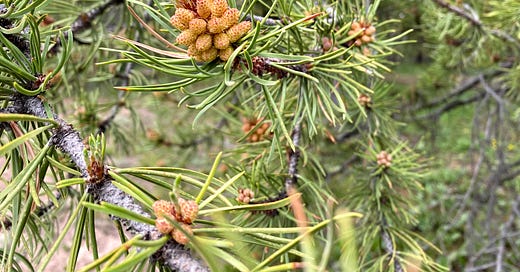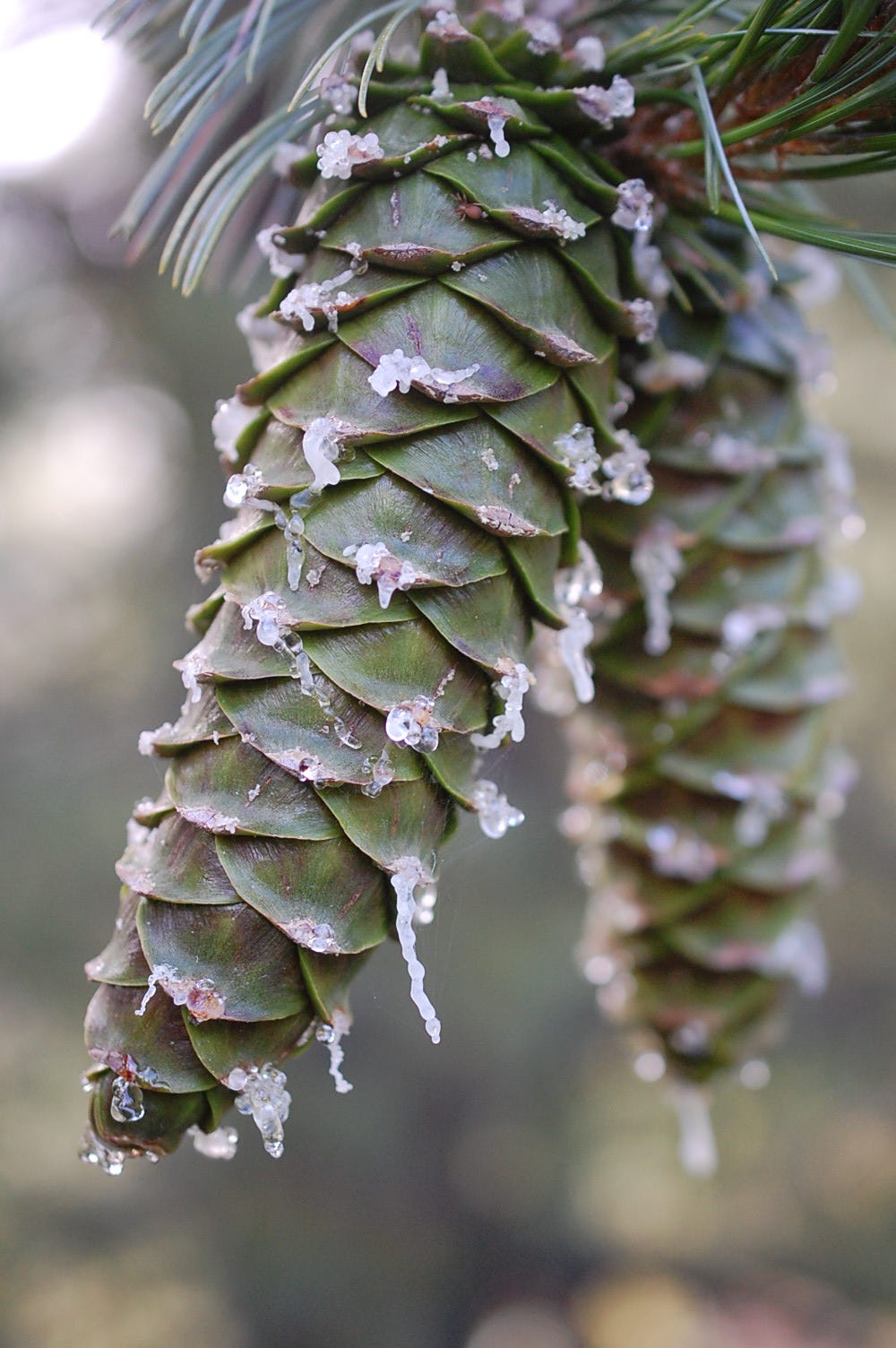What's the Deal with Pine Needle Tea?
Touted as a "suramin containing" remedy, a protection against vaccine shedding, and featured in well-known detoxification protocols, let's take a closer look at pine, its needles, and related conifers
I delved into this topic early summer 2021. I’ve been using pine trees (various species) as medicine for many years. This includes the needles, bark, and sap - and I love the salted, roasted pine nuts my Hopi friends make from the fruits of their foraging that I’ll eat shell and all. So when I heard the claims about “pine needle tea” I was dubious of the validity of these claims.
The initial claims stated that this remedy could protect one from vaccine shedding, or possibly, the “spike protein”. Honestly, neither of these concern me as much as they once did (the latter, absolutely not at all since it has become clear that this concept has been conjured up entirely, but that’s another subject). But what concerned (or at least interested) me initially was the claim that the pine needle tea was effective due to it containing suramin.
Not only was I unable to find any reference to any plant containing suramin anywhere at any time (it’s a synthetic molecule), it appeared that this claim had been conflated with two other ideas. Or perhaps conjured up in some regard by a very broad association.
Best I can trace it, it goes back to something Judy Mikovits said (in regard to being ‘derived from pine needles‘). Later, on Stew Peters’ show, she claimed she never said that. Be that as it may, this information exists nowhere in the public domain (unless it is buried on page 107,803 on a Google search in Russian or Chinese).
But what she did say was that suramin was ‘like a terpene’. My best guess is that she looked at pines, found they contained terpenes, or already knew pines to some extent, and wanted many people to get their hands on this (to help protect them from this virus and other retroviruses she claims are in previous vaccines) so she made this little leap. That’s the best I can piece together from all this.
Suramin is a compound that has been in use for over a century, and has been utilized in experiments, most recently, at San Diego State University on children with ADHD, autism and related “disorders”.
It’s stated that it decreases the activity of a large number of enzymes involved with DNA and RNA synthesis and modification (including reverse transcriptase and telomerase, for example). It’s also known to inhibit a coagulation cascade.
We can leave the idea of suramin right there.
Apparently, a connection was then made with shikimic acid which IS found in pine needles, apparently. I don’t know… perhaps because they both start with the letter “S”? And someone needed to find something in the pine needles to verify the narrative? I really don’t know. It barely makes sense to me, but I am attempting to follow this trail.
Again, apparently, shikimic acid is a known inhibitor of viruses. Well, okay. I would’ve bought that hook, line, and sinker not too long ago but the past couple years have given me ample time to look into such things as viruses (despite the peculiar story I once heard about how they are not alive, yet very dangerous! - something about that never quite sat well with me, but I went on, convincing myself that others knew better). Anyhow, that’s the story.
So then there’s a whole deal on how to optimize for shikimic acid so that you get the most potent preparation (pine needle tea doesn’t really fit that category, but it’s still a great remedy imo) which involves heat and pressure, or perhaps ultrasound (which turns out is a rather effective method for extracting the healing qualities from herbs - if you don’t mind machines making your remedies). But how this relates to vaccine shedding I really have no idea - still.
All that said, the best we do know is that a great many people have become ill, or expressed unusual if not severe symptoms, while in the presence of someone who’s received a covid vaccination. It remains a bit of a mystery to me, but the closest explanation is that of resonance (more on that in a subsequent post).
We still have people advocating for their “protocol” which involves pine needle tea based on nothing else but what I’ve briefly, but somewhat thoroughly, outlined above. Most certainly, someone can love pine needle tea because they do and they enjoy it and their grandmother drank it, etc. etc. BUT that doesn’t necessarily point to it being good for protecting against something which we’re really not sure what it is. But to each their own. Pine needle tea is relatively harmless, or safe to use.
However, there’s been another front of misinformation about the need to use the ‘correct type of pine’ - I hear this proclaimed ad nauseum left and right but it’s a misrepresented concept.
There are no toxic pine needles, per se. I like to say that everything is toxic at the right dosage. That said, there are no outright toxic pine needles at a dose of 4-8oz of standard tea for the vast majority of people anywhere at any time. Not for true pines, aka Pinus species.
People are confusing pine family (Pinaceae) with true pines (Pinus species). True pines have needles born in fascicled clusters along the stem (from 1 to 6). These fascicles usually have a papery sheath (some are deciduous - they fall away quickly). This is true for all white and yellow pines, aka all pines in North America.
The Pine family (Pinaceae) includes related evergreen conifers such as fir (Abies species) and spruce (Picea species) as well as Douglas fir (Pseudotsuga menziesii).
Here's a close up of a flowering limber pine (Pinus flexilis) from high elevation in SW CO.
Note how the short needles on the lower left are visibly sheathed in bundles (brown scale at the base of the emerging bundle). This is what makes it a Pinus species, aka true pine.
People often conflate evergreen (a very general term), or conifer (a specific botanical term that covers all cone bearing plants - aka, in the Gymnosperma ["naked seed"] division) with "pine". That is not the case.
Pictured above is Douglas fir (Pseudotsuga menziesii) another member of the Pine family (Pinaceae). Note the long "wings”, “mouse tails” coming out from beneath the scales of the cone. It is not a true pine, but makes a lovely healing tea for the mucous membranes of the respiratory tract.
People are referring to "toxic pines" such as yew, "yew pine", and even ponderosa pine, etc. As covered above, pines are not toxic, certainly not in the way that yew (Taxus species, Taxaceae) are (please don’t take that personally). Yew are not even in the pine family.
In fact, for the reason that many people are seeking pine needles as medicine right now (high in shikimic acid), there are other trees in that family that have shown even higher contents of shikimic acid than pine, including Douglas fir (pictured above) and fir (Abies species) in studies done in China.
When it comes down to it, I do believe pine needle tea has value in protecting the mucus membranes, improving respiratory health, reducing tendency to blood clotting, and other immune enhancements, and it tastes good!
Fun fact: Mexico has the greatest diversity of pines of any nation (@60 species); pictured above, Pinus strobiformis, known from Arizona to Guatemala.
Also, keep in mind that an age old prescription from the Celtic cultures, for convalescing from a respiratory illness, was to walk daily amongst the pines. The pheromones excreted by the needles, once inhaled, have an immunomodulatory effect on our respiratory and immune systems which can last for up to 30 days. So go take a walk in a pine forest. It is sure to do you some good!






Being bathed in the spirit of pine is my earliest “big” memory. Now that you mention it, it is an experience of being cleansed, embraced, love.
Funny; three days ago I read about how drinking pine needle tea could prevent someone from the 'shedding' of a vaccinated person. I went out and collected some pine needles in New Mexico, but have not brewed them. And now reading your piece, I see that the origins of this idea are perhaps dubious. But, as you say, there are some benefits!